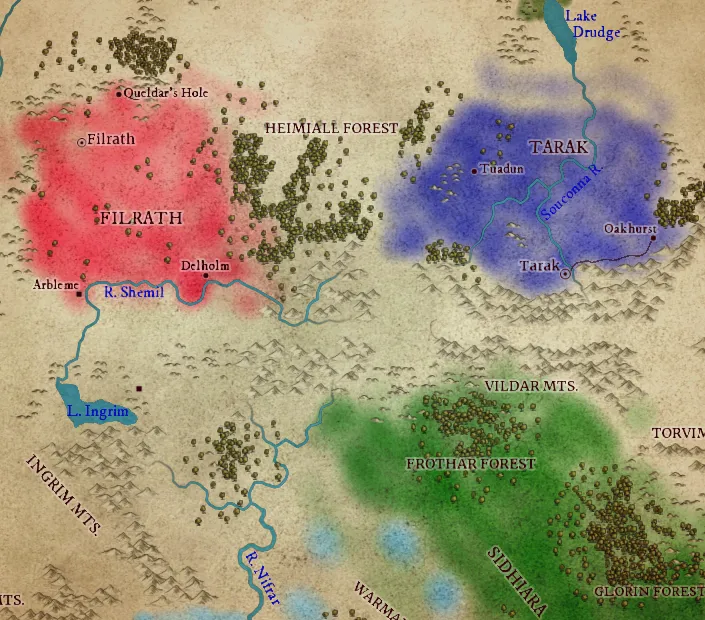I recently finished posting the long-running saga of a 5th Edition D&D campaign I ran, Adventures in Milmar. It was set in my homebrew world, Argull. It went on for a good while, packed with exciting adventures and memorable incidents.
The campaign ended when the group fell apart as a result of out-of-game drama involving some of the players getting involved in some complex and spicy divorce/partner swapping/domestic violence kind of stuff. Worthy of a soap opera, but I'm not the one who needs to write it up !
After an intermission, we reassembled the saner members of the group and added a few new faces. Then we started a new campaign with new characters. It was still set in my homebrew world, this time centred around the Principality of Tarak.
The campaign actually ended up as two separate storylines, with two parties each adventuring in different parts of the Principality. I'll describe each separately, one after the other, even though there is actually some overlap in terms of time within the game world.
The first few posts of this series will cover the setting, and then once that's done I'll move on to the adventure itself, both the design and fun stuff the players did. I hope you enjoy it all, and welcome any feedback (good or bad !)

The Arms of Tarak - created with the Worldspinner Fantasy Heraldry Generator

THE PRINCIPALITY OF TARAK
Location
Tarak is located to the east of Filrath, and north of Sidhiara, separated from them by the wild Heimial forests to the west and the Vildar mountain range to the south. The capital is Tarak City, by the banks of the River Souconna near the southern edge of the Principality, in the foothills of the Vildar Mountains.

Map created by me in Wonderdraft
History
Tarak’s original inhabitants were the Thrakari tribe, a group of horse nomads originating in the far north but driven south by conflicts emanating from the Underice some 3500 years ago. Led by their legendary warlord, Valdar the Conqueror, they settled in the fertile plain, they soon developed a relatively advanced bronze-age agrarian society ruled over by a class of mounted warrior chieftains.
This state of affairs was not to last, and 500 years after founding their kingdom of Thraki, they were overrun by the Sidhiaran elves, who subjected the land to a ruthless regime of slavery and subjugation. When Enrieme rose against the Sidhiarans 900 years ago, the Thraki took the opportunity to do likewise. There followed a bloody 120 year war of independence, initially as an insurgency and later growing into full scale warfare.
During the War of Independence, the fight was led not by mounted chieftains (who had mostly been exterminated by the Sidhiarans), but by the fanatical Priestesses of Andraste and Epona, the Priests of Rigisamus, the Druids of Taranis, and mages of the Cult of Smetrios. Towards the end, a single chieftain emerged from the remnants of the noble class as a figurehead leader for these disparate groups; Prince Mann Blackmont. When the Sidhiarans retired beaten behind the Torvim Mountains, Prince Mann was elected as ruler of Tarak.
Subsequently, the Blackmont dynasty went on to provide Princes for some 500 years, but their history was not a happy one, even though it was glorious and bloody. Many of them met untimely ends in one way or another. The final Prince was Prince Imrar, 300-odd years ago. He was deposed when the Priestesses of Andraste discovered he was attempting to evade death by transforming himself into a lich. His immediate family were sacrificed to propitiate the gods, although a few cadet branches of the family live on quietly in the Principality.
Terrain
The landscape of Tarak consists of an overall slope down and away from the Vildar Mountain range. The southern parts are quite hilly, with significant areas of woodland. Further north, the woodland turns to scattered groves and copses, with low rainfall stunting the growth of the larger trees.
Tarak City, the capital, is actually towards the southern edge of the Principality, in a cleft in the foothills of the Vildar Mountains, putting it in easy reach of the vital mines in those mountains, as well as sited on the upper reaches of the River Souconna.
Climate
Tarak has relatively low precipitation for much of the year, with the mountains to the south providing a barrier to the moisture borne in warm winds from the southern oceans. For most of the year, water for crops originates from springs in the Vildar Mountains, running from south to north in streams and rivers which eventually merge to form the River Souconna.
Winter is a time of northerly winds and snowstorms and it is normal for the land to be blanketed in snow for at least a month or two. The Souconna has been known to freeze over during the harshest winters.
Ecology
Much of Tarak is too dry to support significant levels of agriculture. Areas close to permanent rivers are farmed intensively, mainly for root crops and the hardiest of grains. The rest of the country consists of scrubby grasses which are ideal for raising large flocks of sheep.
In addition to agriculture and domesticated livestock, Tarak is also home to less amenable beasts. As a land surrounded by wilderness on all sides, it experiences regular incursions by hungry monsters as well as orc, goblin and giant kindreds from the mountains.

Next time, I'll describe the economy, social and political setup of Tarak....